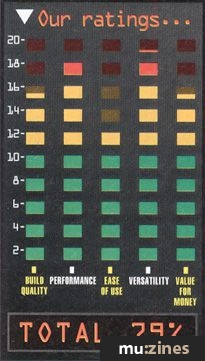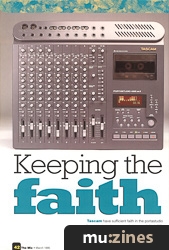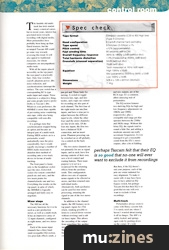Magazine Archive
Home -> Magazines -> Issues -> Articles in this issue -> View
Article Group: | |
Keeping the faith | |
Tascam 488 MKIIArticle from The Mix, March 1995 | |
Rocking, reeling portastudio
Tascam have sufficient faith in the portastudio format to launch an upmarket, re-modelled 488. Danny McAleer puts it through its paces, and sees if he can't teach an old dog a new mix...

The humble old multitrack has kick-started many a musical career, but in recent years, interest has gravitated more towards recording with digital media. More portastudios have probably been hung up than flared trousers, but the revamped Tascam 488 could go some way towards reversing this trend. It will also appeal to traditional musicians, for whom computers are unsympathetic studio tools.
With all the inputs placed accessibly on the top panel, the rear panel is practically bare. Only four switches (on/off, phantom power, dbx noise reduction, and synchronisation) interrupt the surface. The sync switch has a corresponding RCA-type audio input and output. Noise reduction is a subjective thing, and some people tend to prefer Dolby to Tascam's dbx. Whatever your preference, the 488MkII is more than capable of preventing noise wandering onto tape, while also being compatible with non-dbx recordings.
It is perhaps time that synchronisation stopped being an option and became an integral part of a multi-track. Putting MIDI sockets on to a portastudio would undoubtedly raise the price considerably, but it would equally encourage a number of MIDI studio musicians to abandon their method of recording onto a two-track device in favour of multitracking.
The front panel is home only to the headphone socket (just the one), footswitch socket (for remote controlled punch-ins and outs), and the two insert points for channels/tracks one and two. Everything else resides on the top panel; in spite of which, the 488MkII is logically arranged and fairly easy to negotiate.
Mixer stage
The 488 has all the necessary functions for it to be used as a pre-production mixer, as well as a multi-track. It has an impressive array of 12 input channels, configured as eight mono, and two stereo pairs.
Each of the mono input channels has a three band (mid-sweepable) EQ section, two post-fade effects sends, a pan pot and 70mm fader for mixing. A switch to toggle between line, tape, and mix modes, and a tape cue control for recording are also part of each channel. The first four of the eight tracks are mic/line inputs, and have a trim pot to adjust between the different input levels, whilst the other four (and the stereo channels) are line levels only. Of the four mic inputs, the first two have a balanced XLR connection, and an insert point. Phantom powering can be switched on or off globally, via a control on the back panel.
The two stereo channels are not primarily for use as signal inputs, and as such, have few mixing controls of their own, save a level control and routing buttons. Their main purpose is to act as a reciprocal for the returning effects from the auxiliary sends. This configuration allows two sets of separate mono signals to be effected in stereo, and then returned onto individual tracks. Alternatively, both auxiliaries can be used for true stereo processing, returning the signal to one of the two stereo channels.
In addition to the channel inputs, the 488 features on its top panel, inputs for 2Trk return, (making possible to listen to a mixed down version without rewiring) and a sub (or buss) input. This allows the cascading of the output from something like another mixer to be routed through to the Left and right (group 1/2) busses on the 488. These connections, and the monitor and mix outputs, are of the RCA-type. It's a common, albeit annoying trait of portastudios.

The EQ section features two shelving EQs for high and low frequency adjustments (at 10KHz and 100Hz respectively), plus a sweepable mid-range pot that operates between the 250Hz and 5KHz range. Without this feisty EQ, the signals tend to sound a little flat, and adding a moderate amount can really accentuate frequencies. It even managed to get a reasonable sound from the STe's stereo outputs, after a bit of fiddling.
But then, if the EQ doesn't suit your purpose, each of the pots are centre indented for easy alignment. To make it easier still, it may have been nice to have added an EQ bypass switch, but perhaps Tascam felt that their EQ is so good that no-one will ever want to exclude it from recordings.
Multi-track
Portastudios always seem to come with flimsy cassette lids. I've rarely used one where I haven't worried about tearing it off its hinges. The 488's is safely locked, and springs open wide by pushing down on the corner. It's wide enough for cleaning right around the rim, or for loading cassettes without having to wedge them in.
The transport controls are all of the logic variety, and are reassuringly clunky and responsive. The play, pause, and record buttons all have LEDs that either flash (when the operation is about to be performed), or remain lit when activated. Next to the transport controls lie the rest of the tape recording functions. There are eight numeric buttons, which correspond to the tracks on tape. When pressed, the number corresponding to the button flashes on screen; this track is now record-enabled.
Up to four tracks can be simultaneously recorded, which can consist of any combination of tracks one or five, two or six, three or seven, and four or eight.
"perhaps Tascam felt that their EQ is so good that no-one will ever want to exclude it from recordings"
Having digital transport controls has its advantages. Two memory locations can be set, by pushing the MEMO IN and LOC1/LOC2 buttons at the same time.
You can set these at any time during playback, except if the repeat function is active. The repeat function replays the section between the two memory locations over and over, allowing you to finely adjust the mix, or to practise a part ready to record. The RTZ button returns the tape counter to zero, so there are effectively three memory locations with which to mark a piece of music.
Road to somewhere
The 488MkII has a very comprehensive set of routing configurations, which can at first seem a bit baffling. It is actually such a flexible routing system that it's possible to complete a whole recording only using the first two input channels, (thus taking the advantage of the balanced lines and insert points). Each track has two buttons: 1/2 (L/R), and 3/4, and are used in conjunction with the pan pot. By positioning the pan hard left, and depressing the 1/2 (L/R) button, the signal is routed to group output 1 (either track one or five on tape), whilst panning hard right, routes it to group output 2 (track two or six on tape). As well as corresponding to the tracks being recorded on, the groups also determine the monitor output.
With the monitor section's routing buttons, you can selectively listen to any part of the mix, the effects, or tape returns either in from the headphone socket or via the monitor outputs. Pressing the tape cue button sends all the channels/tracks to the headphones, the amount of which is determined by the tape cue pots on each channel. This way, you can set an independent monitor mix that has say, a louder drum part and excludes the strings, making recording another part easier to do.
You can also opt to listen to the 2Trk return (in order to listen to the mix down), or either of the stereo inputs (to monitor the effects). Obviously, any combination can also be selected for monitoring.
If eight tracks just aren't enough, then the 488 can free tracks by 'bouncing' the recorded matter onto a single, or two (in the case of stereo recordings) tracks. This is achieved by assigning the desired tape tracks to the tracks to be bounced down to. You can also record live over the top, as the tracks are combined by switching the input track to multimix mode.
Performing the operation in stereo just requires that you use two tracks, and route each of the existing tracks to the relevant channels using the pan pot. It takes a little experimentation; a couple of times I completely botched the whole track before getting it right. It is also not that difficult to accidentally bounce tape tracks to the new track being recorded.
Verdict

As long as a reasonably good quality cassette is used, something like TDK's SA-X, and the heads are cleaned regularly, very few drop-outs occur, even after several bounces. In fact, with or even without dbx noise reduction, the recording quality is generally unsurpassable with this multi-track. Only once during the review period did some nasty-sounding glitches occur during a recording, and it's still puzzling now as to what the cause was.
It may be a huge leap in price range from something like the Fostex X18H, or even the slightly over-priced Marantz PDM-720, but the Tascam 488MkII has an altogether more professional disposition. Coupled with eight tracks, and such an elegant mode of operation, this is one multi-track you wouldn't be ashamed to have accompany you to the office dinner party. Well behaved and rather racy, if a little expensive.
The essentials...
Spec check
| Tape format | Compact cassette (C30 to 90) High bias (Type II Chrome) |
| Head configuration | 8 track/8 channel hard permalloy |
| Tape speed | 9.5cm/sec (3-3/4ips) ±1% |
| Pitch control | ±12% (approximately) |
| Fast winding time | 80 seconds with a C60 |
| Overall frequency response | 40Hz to 14KHz ±3dB (without dbx) |
| Total harmonic distortion | 1.3% (measured at 400Hz, 0dB level) |
| Crosstalk (channel separation) | 50dB (without dbx) 70dB (with dbx) *both measured at 1KHz 0dB level. |
| Equaliser | High 10KHz ±12dB Mid (parametric) 250Hz to 5KHz ±12dB Low 100Hz ±12dB |
| Dimensions | 528.4 x 128 x 437mm (WxHxD) |
| Weight | 7.1 Kg |
Featuring related gear
Publisher: The Mix - Music Maker Publications (UK), Future Publishing.
The current copyright owner/s of this content may differ from the originally published copyright notice.
More details on copyright ownership...
Control Room
Review by Danny McAleer
Help Support The Things You Love
mu:zines is the result of thousands of hours of effort, and will require many thousands more going forward to reach our goals of getting all this content online.
If you value this resource, you can support this project - it really helps!
Donations for October 2025
Issues donated this month: 0
New issues that have been donated or scanned for us this month.
Funds donated this month: £0.00
All donations and support are gratefully appreciated - thank you.
Magazines Needed - Can You Help?
Do you have any of these magazine issues?
If so, and you can donate, lend or scan them to help complete our archive, please get in touch via the Contribute page - thanks!









